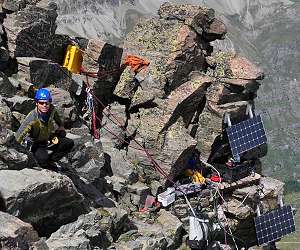Capella Space partners with SpaceNet to expand access to SAR data
Capella Space, an information services company that provides on-demand Earth observation imagery, has announced its partnership with SpaceNet, a nonprofit organization dedicated to accelerating open source, artificial intelligence (AI) applied research for geospatial applications.
Capella joins the collaborative SpaceNet partnership alongside In-Q-Tel’s (IQT) CosmiQ Works, Maxar Technologies, Intel AI and Amazon Web Services (AWS). Capella’s addition to the partnership presents an exciting opportunity to expand SpaceNet’s existing geospatial open source research to a new data type, Synthetic Aperture Radar (SAR). Opening access to this data will help broaden the use of high-quality SAR in a variety of geospatial analytic applications.
“SAR promises substantial value for a wide variety of geospatial applications because, unlike satellite imagery, it is not limited by weather or lighting conditions. Furthermore, SAR phase data can offer additional insights into a particular location such as land subsidence,” said Ryan Lewis, Senior Vice President at IQT and General Manager of SpaceNet.
“Capella’s contribution of an open-source, high-resolution SAR data set is an important next step for SpaceNet, and we are excited to see how participants use this data for machine learning models in an upcoming challenge.”
There is tremendous potential in applying machine learning to SAR data for a range of applications, from natural disaster response to monitoring global supply chain activity, but the industry still faces significant barriers to adoption. Developers and data scientists lack open data and software tools. Capella seeks to help overcome these obstacles through its partnership with SpaceNet and the development of a new SAR user community.
“Traditionally, this type of high-resolution SAR data has only been used by governments for defense applications and has not been easy to access. By opening access to this type of data and lowering barriers to adoption, we aim to foster broad and rapid advances in commerce, conservation and well-being across many industries,” said Andrew Ulmer, Vice President of Business Development at Capella Space.
“We encourage industry leaders, academics and NGOs to experiment with the data, as it’s our collective imagination that will unlock the most value and transform how we live.”
The Capella User Community will broaden the adoption of high-resolution SAR data to solve a range of global issues. Data scientists and software engineers will have access to free and open Capella data along with tools and techniques to work more easily with SAR data. The company invites academics, non-government organizations (NGOs), governments, and companies to join Capella’s User Community at capellaspace.com/community.
Related Links
Capella User Community
Earth Observation News – Suppiliers, Technology and Application
|
We need your help. The SpaceDaily news network continues to grow but revenues have never been harder to maintain. With the rise of Ad Blockers, and Facebook – our traditional revenue sources via quality network advertising continues to decline. And unlike so many other news sites, we don’t have a paywall – with those annoying usernames and passwords. Our news coverage takes time and effort to publish 365 days a year. If you find our news sites informative and useful then please consider becoming a regular supporter or for now make a one off contribution. |
||
|
SpaceDaily Contributor $5 Billed Once credit card or paypal |
SpaceDaily Monthly Supporter $5 Billed Monthly paypal only |
|

![]()
Monitoring the Matterhorn with millions of data points
Zurich, Switzerland (SPX) Aug 17, 2019
The summer heatwave of 2003 triggered a rockfall that shocked both researchers and the general public: 1,500 cubic metres of rock broke away from the Hoernli ridge – a volume roughly equivalent to two houses. The fracture event exposed bare ice on the surface of the steep scarp. Experts soon realised that the record temperatures had warmed the rock down to such a depth that the ice contained in its pores and fissures had melted. This effectively caused a sudden reduction of the bonding holding the rock … read more
